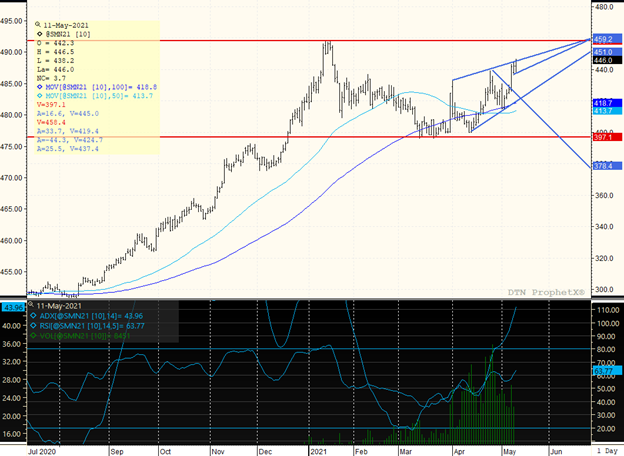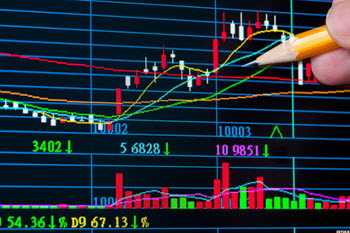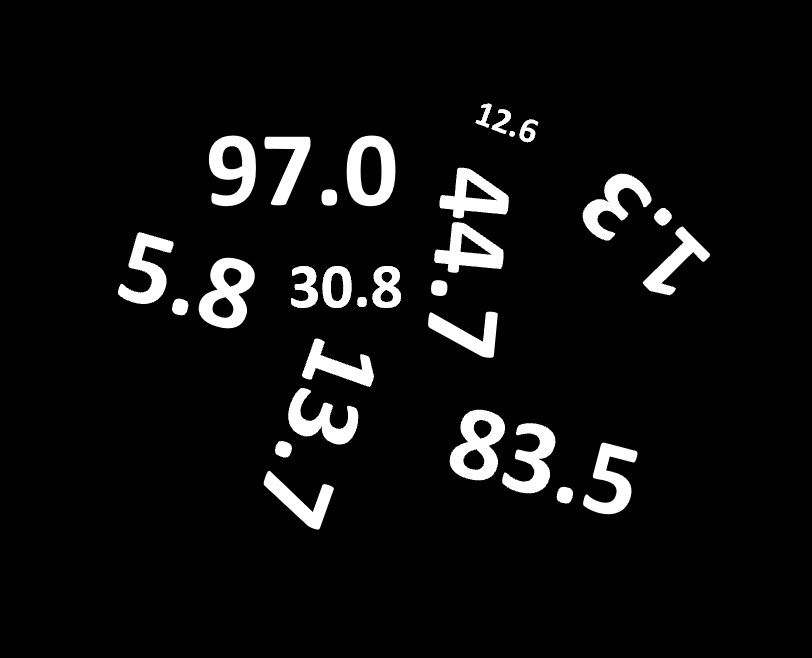SPREADS
July crush is trading at 84.58c/bu while oilshare trades to 41.69% as it continues to correct. July /Nov bean spread bounces back to 1.81 3/4c from 1.73 1/2c and closes at the highs. Would look for further strength. Jly/Dec corn trades up to 1.09c from a break that took values to an 87c inverse level. Would also look for further strength with the inverse low at 1.02 1/4c. Jul /Dec meal inverse strengthens to $28.80 from $24.80. July wheat/corn trades from 18 1/2c to 23 3/4c.
PALM OIL
July down 23 ringgits to close at 4,345 ringgit/mt, lower for a second session as pressure from rising inventories and a better outlook for US crop plantings counted a surge in May exports so far.
NEWS
Stocks are down 300 pts with crude oil trading to $63.86/barrel and the US dollar down to 90.05.
CALLS
Calls are as follows:
beans: 7-9 higher
meal: 3.50-3.80 higher
soyoil: 25-30 lower
corn: 6-9 higher
wheat: 7-9 higher
canola: 37.80 lower
BUSINESS
USDA reports 680,000 mt of corn sold to China in 21/22
TECHNICALS
July Beans: Prices are congesting from $15.75 to $15.99, but most importantly is that the market is full supported on pullbacks and the weakness is temporary. The market bounced back to close at the top of the trading range. Formations taking prices higher are more friendly than bearish, and would expect to likely test $16.00. If we trade over, would look to go to $16.30 where crossing lines of resistance are. Look for pullbacks to own.
first support: $15.85/$15.88
resistance: $15.99/$16.05
possible range: much the same or higher
July Meal: Prices are now trending higher and settled over major resistance at $445.00. The close was towards the higher end of the range indicating that we see upside follow-through. Would look for prices to now rally towards $450.00 minimally as the break-out looks to be confirmed. Higher meal may support beans if they drive to new contract highs.
first support: $442.00/$443.00
resistance: $448.00/$449.00
possible range: much the same
July Soyoil: Prices are now congesting from 63c to 64c, but it may be just a matter of time before we rally again towards recent highs. The bottom of the trading range is from 6280c to 63c, and prices have closed higher at 6360c. Would look for a pullback towards 63c still as a buying opportunity as the overall contract highs still do not seem to be placed.
first support: 6325c
resistance: 6420c
possible range: much the same
July Corn: Prices pulled back to try to define the lower end of the trading range and has a successful test of $7.00 given the 20c higher close. Would look for pullbacks to continue to see support and the chart bull formation has not been dented. Would still look for a possible rally towards $7.50.
first support: $7.15/$7.18
resistance: $7.25/$7.30
possible range; much the same
July Wheat: Wide trading range now from $7.20-0$7.70, and when given the chance this is the market that breaks the most. Prices fell to the lowest point of price congestion and held, indicating that we could possibly trade back towards $7.50 again. The major direction is sideways, but would look for $7.20 to be solid support, and if short would think about covering or going long.
first support: $7.30/$7.33
resistance: $7.43/$7.45
possible range; much the same
JULY MEAL
The major direction has now turned sideways/higher from sideways, and the chart is building in support at the bottom. The vertical trade higher on Friday was indicative of a strong market where prices tend to find upside follow-through. The trade over $445.00 was through the major resistance line in blue at the top of the chart. This increases the chance of upside follow-through towards $450.00 to $455.00. The overall trading range now moves up to $420.00 to $455.00 or higher, and trendline support for the day is $440.00 would we go there.

TAGS – Feed Grains, Soy & Oilseeds, Wheat, North America



 The Q1 2024 GDP was 1.6 percent, well below the pre-report consensus expectation of 2.4 percent, and down from 3.1 percent in Q1 2023 and 3.4 percent in Q4 2023. That rate was the slowest in almost two years, dating back to Q2 2022. Recall that in the 2 February Ag Perspectives report on...
The Q1 2024 GDP was 1.6 percent, well below the pre-report consensus expectation of 2.4 percent, and down from 3.1 percent in Q1 2023 and 3.4 percent in Q4 2023. That rate was the slowest in almost two years, dating back to Q2 2022. Recall that in the 2 February Ag Perspectives report on...
 As WPI readers likely well know by now, U.S. gross domestic product (GDP) grew at an inflation- and seasonally-adjusted 1.6 percent rate in Q1 2024, which missed economist’s 2.4 percent expectations. The data sent shockwaves through U.S. financial markets with U.S. stocks and bonds openin...
As WPI readers likely well know by now, U.S. gross domestic product (GDP) grew at an inflation- and seasonally-adjusted 1.6 percent rate in Q1 2024, which missed economist’s 2.4 percent expectations. The data sent shockwaves through U.S. financial markets with U.S. stocks and bonds openin...
 Wheat remains the star of the ag commodity space this week with the rally continuing on challenging weather prospects for the U.S. HRW region, Europe, and the Black Sea. Until a few weeks ago, there were few doubts about the 2024 crop being able to supply the expected demand, but now reduced yi...
Wheat remains the star of the ag commodity space this week with the rally continuing on challenging weather prospects for the U.S. HRW region, Europe, and the Black Sea. Until a few weeks ago, there were few doubts about the 2024 crop being able to supply the expected demand, but now reduced yi...